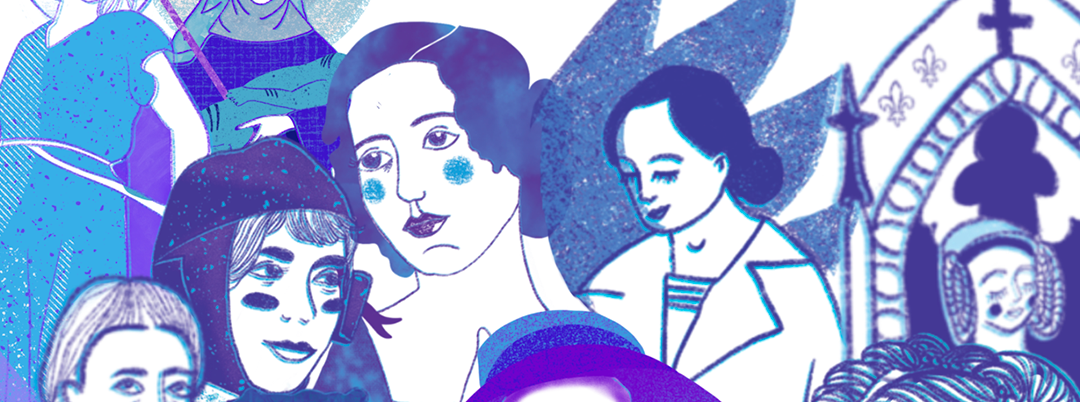Nos femmes wallonnes

Article author :
“Nos femmes wallonnes”, is a series of podcasts about women who have left their mark on the history of Wallonia. These badasses of yesterday and today, shine on our Walloon heritage.
Sainte Gertrude
Admittedly, we don’t really know the date of her birth, but Gertrude was born more or less in 626, into a rather well-to-do family. She even had links with Clovis’ family. So there you have it. And as with any family from the aristocracy, luckily, the women were educated, literate and skilled. As a result, she was only 20 when her mother entrusted her with the management of the monastery, making her the first abbess and patron saint of the town of Nivelles. But Gertrude’s vocation to serve Christ had been with her since she was a child…
Hélène Dutrieu
She was only 14 when she broke the world record for bicycle speed. Paris urged her to come to the capital, but her parents objected. But Hélène, determined and a bit of a daredevil, gets on her bike, takes the train, arrives in Paris and looks for the Buffalo velodrome. This was to be the start of an incredible career for the young Tournaisienne.
Léonie de Waha
Léonie is a hyper-stimulated child. Her father takes her everywhere: as soon as he takes the train and leaves the Cité Ardente for the capital, she accompanies him, and he takes the opportunity to read her the newspaper and tell her about current political and social events. At the age of 12, Léonie already has a critical, tolerant and clearly democratic view of the world. At a time when she could have been completely destroyed by the loss of her parents and husband, she decides instead to devote all her time, fortune and real estate, intellectual and financial inheritance to the education of young girls.
Anna Boch
The Boches are a wealthy family. They sell well, and their name is internationally renowned. And like any good bourgeois family, Anna was to receive an education in the arts: she was taught drawing, music and painting. But at the time, in the 19th century, this type of education was hyper-patriarchal: it was assumed that if a young woman was sensitive to the arts, then she would be delicate, neat and a good housewife. The idea of awakening an artistic vocation is not really the aim of such training. Except that Anna Boch is different from the others…
Amélie Nothomb (Province of Luxembourg)
Amélie is what we call a precocious baby. She was only 3 or 4 when she started reading. She was learning on her own. Well, she decided to talk very late in life, but she already had a particular taste for literature, because she had a lot to say! The funny thing is that, in the Nothomb family, it’s Juliette who writes.
Madeleine Ozeray (Province of Bouillon)
Madeleine tries her hand at the 6th art in spite of herself. At just 6, she was sent to the Bouillon local school. Big problem: she wasn’t baptized. And in this time of war, religion is very important. The girls at school rejected her, even calling her a filthy heathen. And it’s in this troubled school environment that she takes refuge in her attic, playing alone. Well, not so alone… because she gives life to Pauline, a fictional character with whom she talks, laughs and cries. Just living. And without realizing it, she’s building her future: because at 15, she’s off to the capital, to the Brussels Conservatory, where she wins a first prize in acting.
Marie d’Artois (Province of Namur)
Although the traditions of the time dictated that the eldest son should take over power on the death of the father, for 7 years it was Marie who found herself thrust into the limelight, taking over the political, financial and real estate management of her late husband.
Marie Mineur (Province of Liège)
Marie was born in Verviers, a town at the forefront of the Industrial Revolution. It was the Manchester of Liège. And Marie came from an ultra-poor family, working in a factory from the age of 8. Then, over the course of her life, she accumulated a series of service jobs: she went from seamstress to laundress, even having been a servant at one time. When she opened her eyes, she was 41. She’s in a room in Dison on November 2, 1871, and wakes up to the shouting of a would-be rebel. It was Mina Puccinnelli who triggered Marie Mineur’s militant commitment.
Euphrasie Mbamba
Euphrasie is very intelligent. She’s the gem of the family, and everyone believes in her. The family heritage was about to be abandoned. And it was full of emotion and love for her native land that Euphrasie decided to give it all up and become a chocolatier to enable her brothers and sisters in Cameroon to live decently without depending on big capitalist industries. And so she created Sigoji.
Les sorcières de Chaumont
Until the end of the 16th century, witches and sorcerers were seen as diviners and healers, indispensable for protecting villages. At the end of the 16th century, a turning point was reached: recurring famines and epidemics, coupled with the Church’s desire to reign supreme over Europe, provided fertile ground for the appearance of a new legal text. Briefly, in 1592, Philip 2 issued his edict criminalizing witches and sorcerers. And to limit the spread of the devil’s mark (dixit at the time, eh?) all the witch’s personal belongings, as well as the documents in her file, were burnt along with her. This explains why sources and evidence of these judgments are very rare… But in Chaumont’s matrimoine, there are traces of 2 cases of witch trials.
For more information on the project, click here.
A story, projects or an idea to share?
Suggest your content on kingkong.




